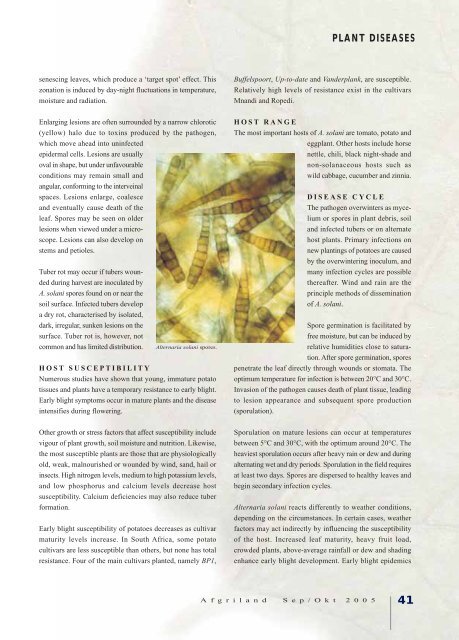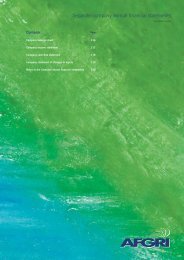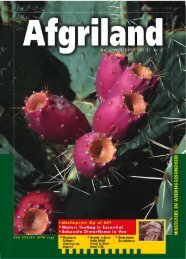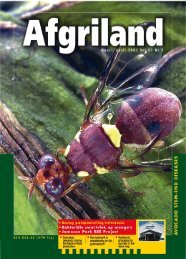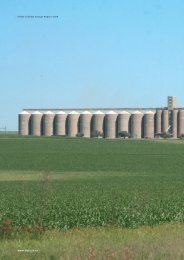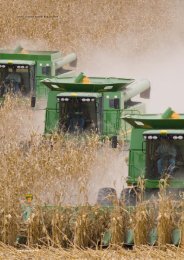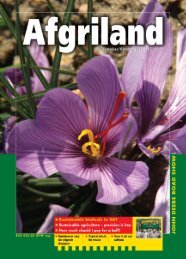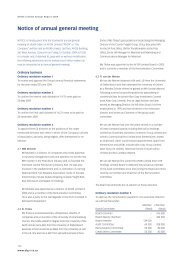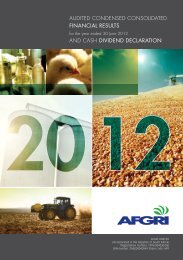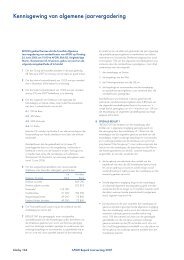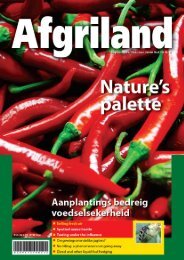Service to manage wildlife disease - AFGRI
Service to manage wildlife disease - AFGRI
Service to manage wildlife disease - AFGRI
You also want an ePaper? Increase the reach of your titles
YUMPU automatically turns print PDFs into web optimized ePapers that Google loves.
senescing leaves, which produce a ‘target spot’ effect. This<br />
zonation is induced by day-night fluctuations in temperature,<br />
moisture and radiation.<br />
Enlarging lesions are often surrounded by a narrow chlorotic<br />
(yellow) halo due <strong>to</strong> <strong>to</strong>xins produced by the pathogen,<br />
which move ahead in<strong>to</strong> uninfected<br />
epidermal cells. Lesions are usually<br />
oval in shape, but under unfavourable<br />
conditions may remain small and<br />
angular, conforming <strong>to</strong> the interveinal<br />
spaces. Lesions enlarge, coalesce<br />
and eventually cause death of the<br />
leaf. Spores may be seen on older<br />
lesions when viewed under a microscope.<br />
Lesions can also develop on<br />
stems and petioles.<br />
Tuber rot may occur if tubers wounded<br />
during harvest are inoculated by<br />
A. solani spores found on or near the<br />
soil surface. Infected tubers develop<br />
a dry rot, characterised by isolated,<br />
dark, irregular, sunken lesions on the<br />
surface. Tuber rot is, however, not<br />
common and has limited distribution.<br />
Alternaria solani spores.<br />
HOST SUSCEPTIBILITY<br />
Numerous studies have shown that young, immature pota<strong>to</strong><br />
tissues and plants have a temporary resistance <strong>to</strong> early blight.<br />
Early blight symp<strong>to</strong>ms occur in mature plants and the <strong>disease</strong><br />
intensifies during flowering.<br />
Other growth or stress fac<strong>to</strong>rs that affect susceptibility include<br />
vigour of plant growth, soil moisture and nutrition. Likewise,<br />
the most susceptible plants are those that are physiologically<br />
old, weak, malnourished or wounded by wind, sand, hail or<br />
insects. High nitrogen levels, medium <strong>to</strong> high potassium levels,<br />
and low phosphorus and calcium levels decrease host<br />
susceptibility. Calcium deficiencies may also reduce tuber<br />
formation.<br />
Early blight susceptibility of pota<strong>to</strong>es decreases as cultivar<br />
maturity levels increase. In South Africa, some pota<strong>to</strong><br />
cultivars are less susceptible than others, but none has <strong>to</strong>tal<br />
resistance. Four of the main cultivars planted, namely BP1,<br />
PLANT DISEASES<br />
Buffelspoort, Up-<strong>to</strong>-date and Vanderplank, are susceptible.<br />
Relatively high levels of resistance exist in the cultivars<br />
Mnandi and Ropedi.<br />
HOST RANGE<br />
The most important hosts of A. solani are <strong>to</strong>ma<strong>to</strong>, pota<strong>to</strong> and<br />
eggplant. Other hosts include horse<br />
nettle, chili, black night-shade and<br />
non-solanaceous hosts such as<br />
wild cabbage, cucumber and zinnia.<br />
DISEASE CYCLE<br />
The pathogen overwinters as mycelium<br />
or spores in plant debris, soil<br />
and infected tubers or on alternate<br />
host plants. Primary infections on<br />
new plantings of pota<strong>to</strong>es are caused<br />
by the overwintering inoculum, and<br />
many infection cycles are possible<br />
thereafter. Wind and rain are the<br />
principle methods of dissemination<br />
of A. solani.<br />
Spore germination is facilitated by<br />
free moisture, but can be induced by<br />
relative humidities close <strong>to</strong> saturation.<br />
After spore germination, spores<br />
penetrate the leaf directly through wounds or s<strong>to</strong>mata. The<br />
optimum temperature for infection is between 20°C and 30°C.<br />
Invasion of the pathogen causes death of plant tissue, leading<br />
<strong>to</strong> lesion appearance and subsequent spore production<br />
(sporulation).<br />
Sporulation on mature lesions can occur at temperatures<br />
between 5°C and 30°C, with the optimum around 20°C. The<br />
heaviest sporulation occurs after heavy rain or dew and during<br />
alternating wet and dry periods. Sporulation in the field requires<br />
at least two days. Spores are dispersed <strong>to</strong> healthy leaves and<br />
begin secondary infection cycles.<br />
Alternaria solani reacts differently <strong>to</strong> weather conditions,<br />
depending on the circumstances. In certain cases, weather<br />
fac<strong>to</strong>rs may act indirectly by influencing the susceptibility<br />
of the host. Increased leaf maturity, heavy fruit load,<br />
crowded plants, above-average rainfall or dew and shading<br />
enhance early blight development. Early blight epidemics<br />
Afgriland Sep/Okt 2005<br />
41


